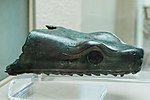Palace of Daphne
Great Palace of ConstantinopleHouses completed in the 4th century

The Palace of Daphne (Greek: Δάφνη) was one of the major wings of the Great Palace of Constantinople, the capital of the Byzantine Empire (modern Istanbul, Turkey). According to George Codinus, it was named after a statue of the nymph Daphne, brought from Rome. The exact layout and appearance of the palace is unclear, since it lies under the Sultan Ahmed Mosque, and the only surviving evidence comes from literary sources. Jonathan Bardill, however, has suggested that the peristyle with mosaics adjoining an apsed hall, excavated by the Walker Trust excavations in 1935-7 and 1952-4, could be the Augusteus of the Daphne Palace.
Excerpt from the Wikipedia article Palace of Daphne (License: CC BY-SA 3.0, Authors, Images).Palace of Daphne
Atmeydanı Caddesi, Istanbul
Geographical coordinates (GPS) Address Nearby Places Show on map
Geographical coordinates (GPS)
| Latitude | Longitude |
|---|---|
| N 41.006 ° | E 28.976 ° |
Address
Sultanahmet Camii
Atmeydanı Caddesi
34122 Istanbul
Türkiye
Open on Google Maps








